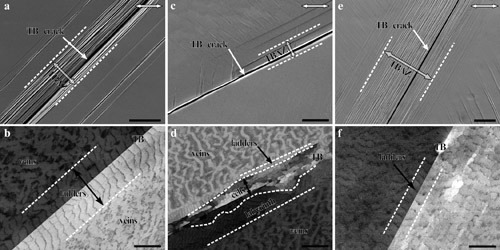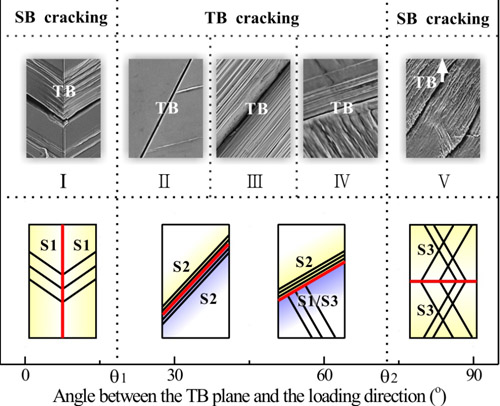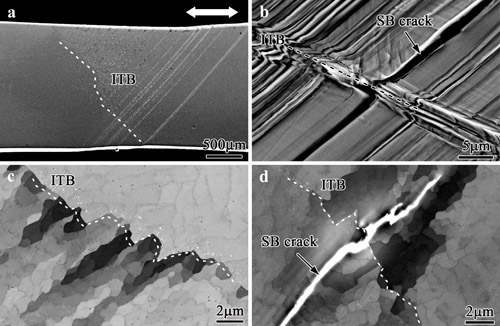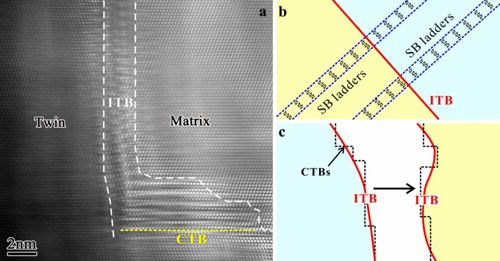It is well-known that grain boundaries (GBs) and twin boundaries (TBs) play crucial roles not only in strengthening and toughening metallic materials under unidirectional deformation, but also in improving their fatigue cracking resistance under cyclic deformation. Generally, the GBs could improve the yield strength of materials; nevertheless, the GBs are the weak and preferential sites for fatigue cracking.
Prof. ZHANG Zhefeng’s group in Materials Fatigue and Fracture division of Shenyang National Laboratory for Materials Science (SYNL) has done a series of low-cycle fatigue experiments on Cu bicrystals with high- or low- angle GBs. They found that no matter what angle is between the loading direction and the high- or low- angle GBs, the fatigue cracking mechanisms are exclusively determined, that is, the high-angle GBs are always the preferential fatigue cracking sites while the low-angle GBs never form fatigue crack. The relevant works have been published in Progress in Materials Science, 53 (2008) 1025.
Since TBs show advantages in strengthening and toughening metallic materials simultaneously, Dr. ZHANG Zhenjun from Prof. ZHANG Zhefeng’s group employed several Cu alloys with annealed TBs to investigate the corresponding fatigue cracking mechanisms. The results demonstrate that low-angle GBs are the strongest in resisting fatigue cracking, high-angle GBs are the weakest, and TBs are in between which is influenced by the stacking fault energy (SFE) and grain orientation. Through analyzing the dislocation–TB interaction and the damage behavior of TBs, a new parameter, defined as the difference in Schmid factors (DSF), was proposed to describe the effects of crystallographic orientation on the fatigue cracking behaviors of TBs. A semi-quantitative criterion was established among DSF, SFE and the critical conditions of TB cracking. It is found that the TB cracking occurs more easily with lower SFE and higher DSF. The relevant works have been published in Acta Materialia, 60 (2012) 3113 & Applied Physics Letters, 101 (2012) 011907.
To further reveal the origins of TBs during cyclic deformation, Dr. LI Linlin from Prof. ZHANG Zhefeng’s group successfully prepared Cu bicrystals with a sole coherent or incoherent TB and designed a series of fatigue experiments. It was found that, differ from high- or low- angle GBs, the fatigue cracking mechanisms of the coherent TBs are concerned with the TB inclination angle with respect to the loading direction. As shown in Figure 1, when the angle between the TB and the loading direction is between about 20~70°, the slip bands parallel to the TB tend to concentrate at the TB with shear damage which leads to the preferential TB fatigue cracking. When the TB is parallel or perpendicular to the loading direction, the slip bands in the grain interior sustain the main plastic deformation and there is good strain compatibility near the TB. Hence the fatigue cracking nucleates along the slip bands preferentially. As summarized in Figure 2, the connection between the inclination angles and the fatigue cracking mechanisms are figured out for the first time, which provides possibility for controlling the fatigue cracking resistance of materials.
Generally, there are also abundant incoherent TBs coexisting with coherent TB in materials with deformation, annealing or growth twins. It is desirable to investigate their fatigue cracking mechanisms of incoherent TBs which is lack of clarification so far. It is found that under certain circumstance, the slip bands are continuous across the incoherent TB and the fatigue crack nucleates along the SBs preferentially as shown in Figures 3a and 3b. The dislocation arrangements are shown in Figure 3c and 3d which demonstrate that the fatigued incoherent TB has evolved into parts of dislocation cells. Due to the special crystallographic orientation, the slip bands could transfer through the ITB; meanwhile, the ITB could migrate with the motion of partial dislocations as illustrated in Figure 4a. Both the penetrability and mobility relieve the pilling-up of dislocations at the incoherent TB and contribute to the high fatigue cracking resistance of the incoherent TB. The mechanisms are sketched in Figures 4b and 4c. The relevant works about the coherent and incoherent TBs have been published in Acta Materialia, 61 (2013) 425, Scientific Reports, 4 (2014) 3744, Nature Communications, 5 (2014) 3536 & Acta Materialia, 2014.
It could be concluded there are two kinds of fatigue cracking mechanisms of various interfaces, impingement cracking and shear cracking. The impingement crack is related to the piling-up of dislocations and the strain incompatibility at the interface, i.e. the GBs are more easily to form fatigue crack with much serious pilling-up (e.g. above cracking along high-angle GBs or some TBs). However, the shear crack is associated with the strain localization, i.e. the shear crack may occur more easily with higher degree of strain localization (e.g. above cracking along slip band or inclined TB). All the above results could provide reference and guidance for optimal material design with high fatigue performance.

Figure 1: Surface morphologies and dislocation arrangements of the bicrystals with an inclined TB. (Image by IMR)

Figure 2: General fatigue cracking mechanisms of the twinned bicrystals with all possible TB inclinations (0° to 90°). (Image by IMR)

Figure 3: The surface deformation morphology and subsurface dislocation arrangement of the fatigued bicrystal. (Image by IMR)

Figure 4: The high-resolution TEM observation of the fatigued ITB and the sketch for the dislocation penetration and ITB migration. (Image by IMR)
Contact:
ZHANG Zhefeng
Shenyang National Laboratory for Materials Sciences, Institute of Metal Research, Chinese Academy of Sciences, 72 Wenhua Road, Shenyang, 110016, P. R. China
E-mail: zhfzhang@imr.ac.cn
Tel: 0086-24-23971043
Materials Fatigue and Fracture Division